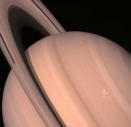|
|
|
| | | :: Friday, May 14, 2004 :: |
Today In History

At first, the launch of the Skylab space station appeared to go perfectly.
And, indeed, it had—for about a minute.
The workshop was launched atop the SA-513 booster on May 14, 1973, in what was to be the final flight of the mighty Saturn V. The powerful rocket which had sent men to the Moon took its bow in a two-stage configuration, since the station took the place of the S-IVB third stage.
Ten minutes after liftoff, Skylab was in orbit 271 miles above the Earth. Ground controllers watched as it began flawlessly moving through the checklist of tasks to be performed upon its arrival in space. The successful jettison of a radiator cover meant that refrigerators could be switched on. The payload shroud covering the docking adapter and Apollo Telescope Mount peeled away, and the ATM rotated into position perpendicular to the workshop. When it was in place, the mount’s four solar panels unfolded into their X shape.
The only significant anomaly, a report that the micrometeroid shield had deployed early, had not been reflected in further telemetry, and was dismissed as a false signal. Unfortunately, however, such was not the case.
During the launch of the Saturn V, the forward end of Skylab—the docking adapter, the airlock module, and the Apollo Telescope Mount were placed under a nosecone shroud, which served to make them more aerodynamic, but also protected them during launch. The workshop itself, being a modified booster stage, had no such covering. Items on the exterior of the workshop, including the main solar panels and the micrometeroid shield, were on the exterior of the rocket during flight. The solar wings were folded up against the body of the S-IVB, to be deployed in orbit.
About a minute into the launch, flight controllers noticed a strange sideways motion in the rocket, shortly before it reached Max Q, the point of maximum aerodynamic pressure on the vehicle. As the powerful booster sped through the atmosphere, the airflow tore loose the 0.025 inch-thick micrometeroid shield. As the shield came loose, it tore off one of the workshop’s solar panels, and wrapped around the other, preventing it from deploying.
Half an hour after launch, the Flight Director in Houston had been informed of anomalous signals from both the meteoroid shield and the solar panels. The full direness of the situation began becoming apparent about 41 minutes into the mission, the point at which the solar panels were supposed to deploy. Ground controllers waited for the station come into range of the Carnarvon, Australia tracking station so that it could report the status of the deployment. The telemetry signals were confusing, with some indications that the wings had been released but were not fully deployed and other indications that both wings were completely gone. The shortage of electric power on the station supported the latter. Commands were sent to Skylab for it to continue deploying the panels, but to no avail.
Further telemetry confirmed the worst—the station was badly crippled, in not one, but two ways that had the potential to end the Skylab mission before it had truly begun. While the micrometeroid shield was to serve to protect the workshop from impacts, despite its name, it actually performed a far more important role. The shield shaded the workshop, allowing the temperate inside to be kept at a comfortable level despite the exposure to direct sunlight. While research showed that the risk of damage from impact with a meteoroid or orbital debris was relatively slight, the dangers posed by overheating were far greater. Not only could the heat make things very uncomfortable for any human occupants and ruin scientific experiments, it would also cause equipment malfunctions which could render the station unusable.
More Info
:: back to blog front page ::
|
|


